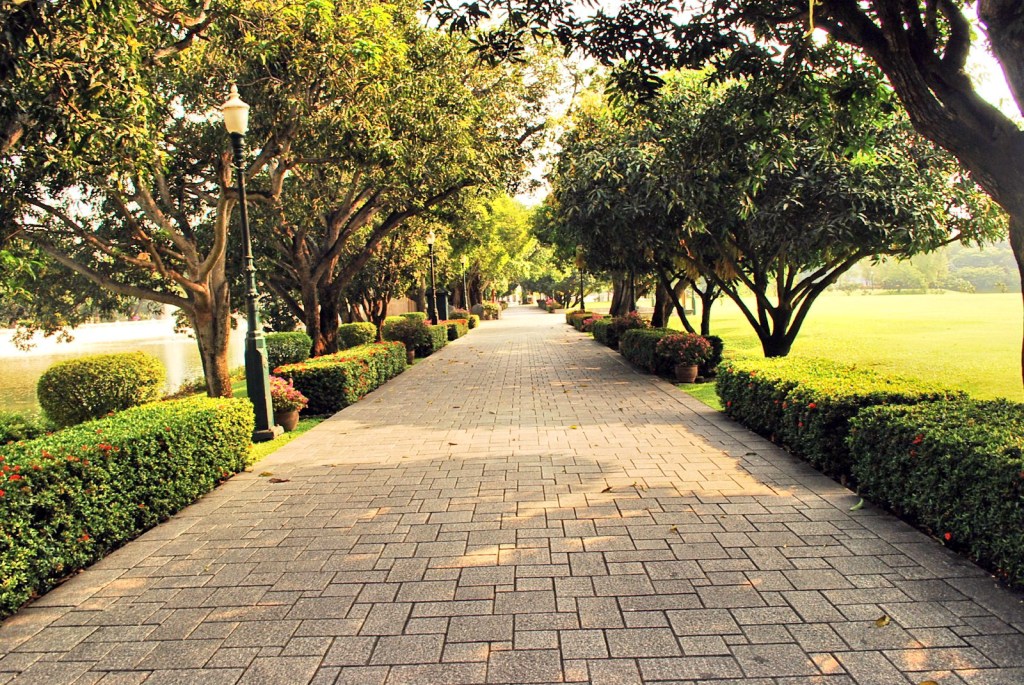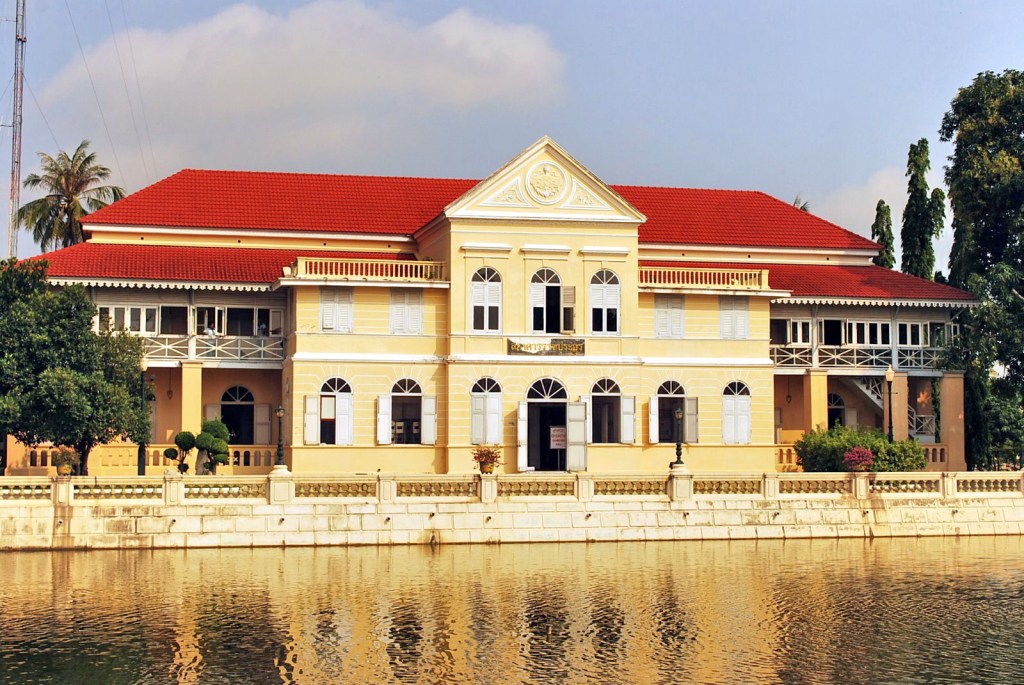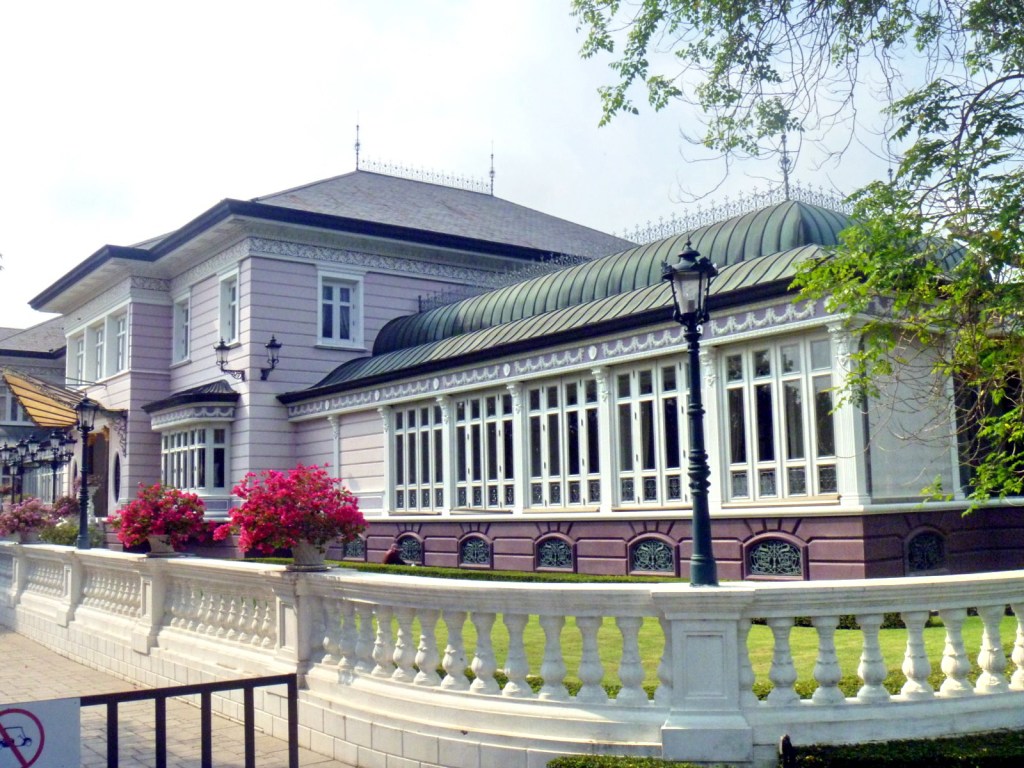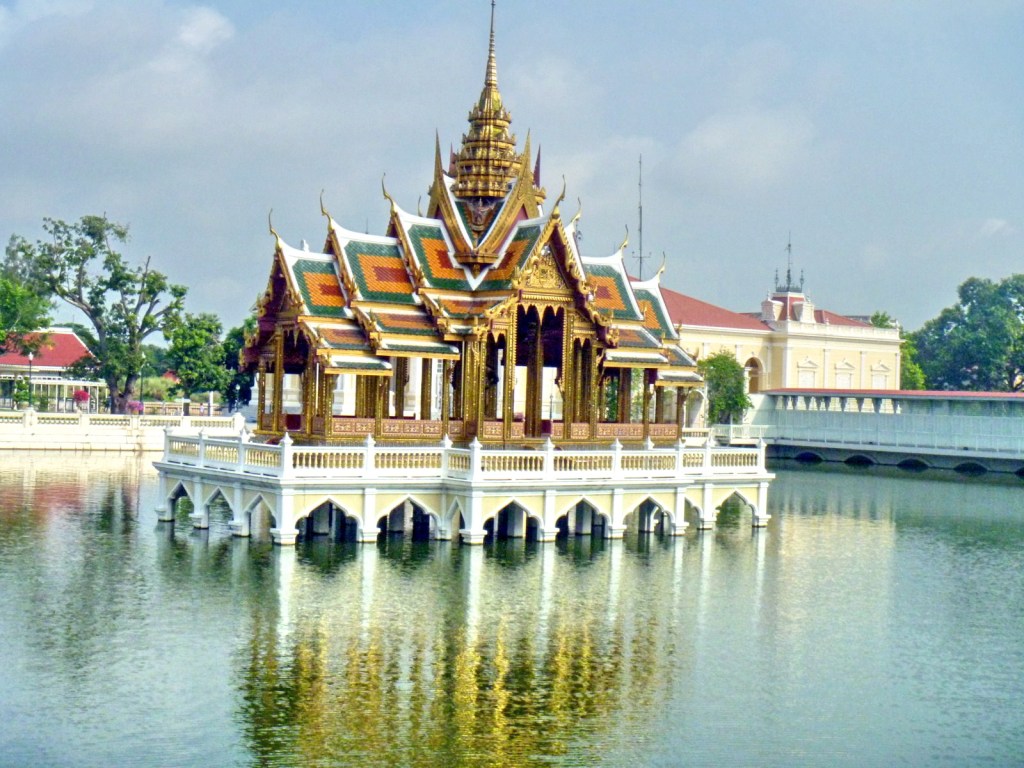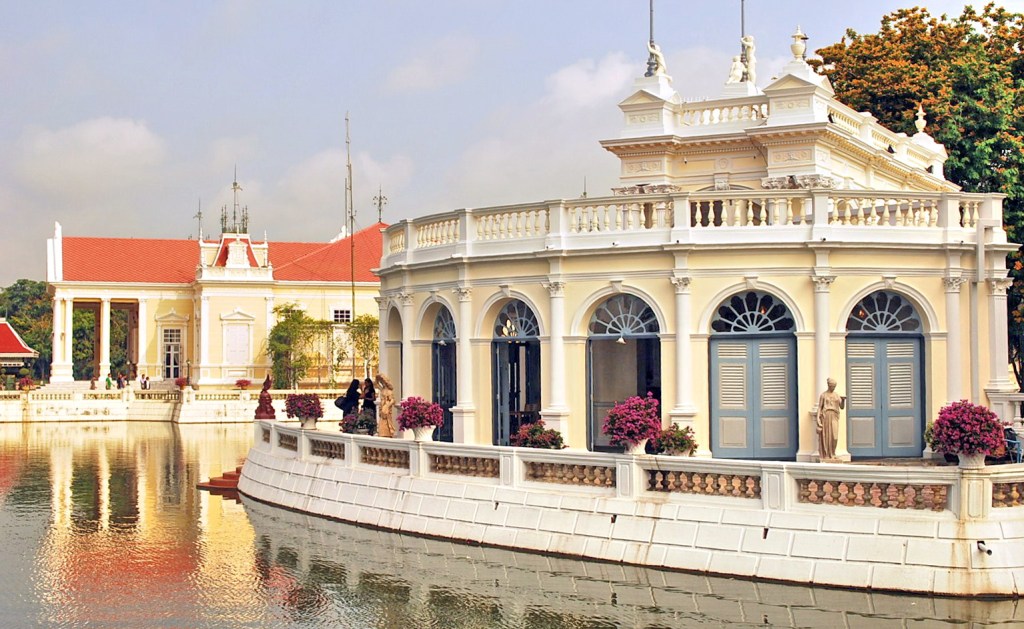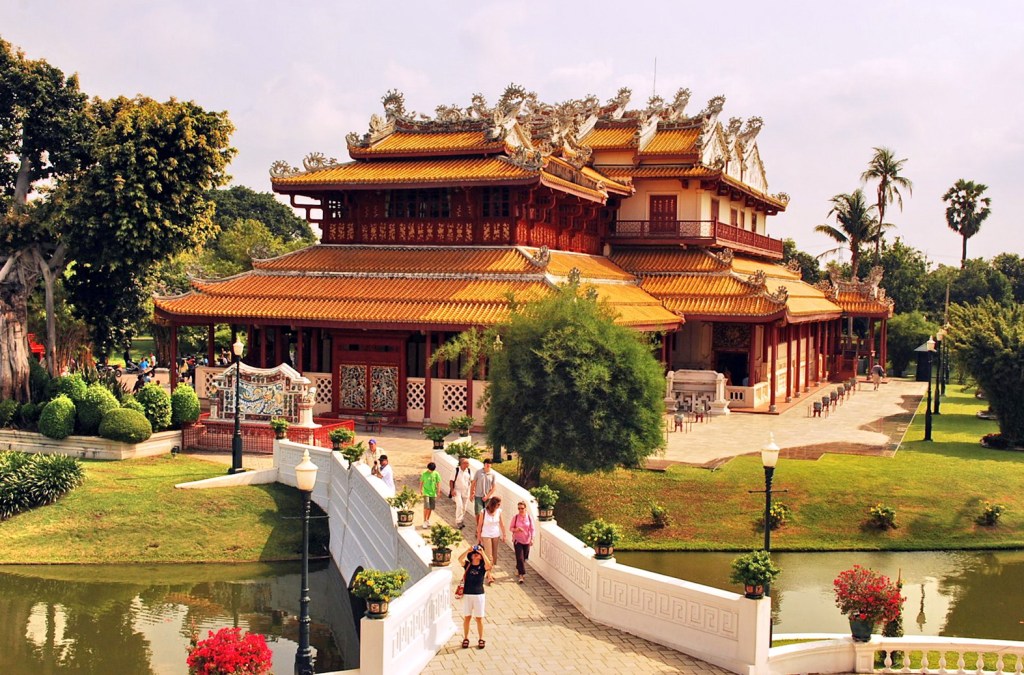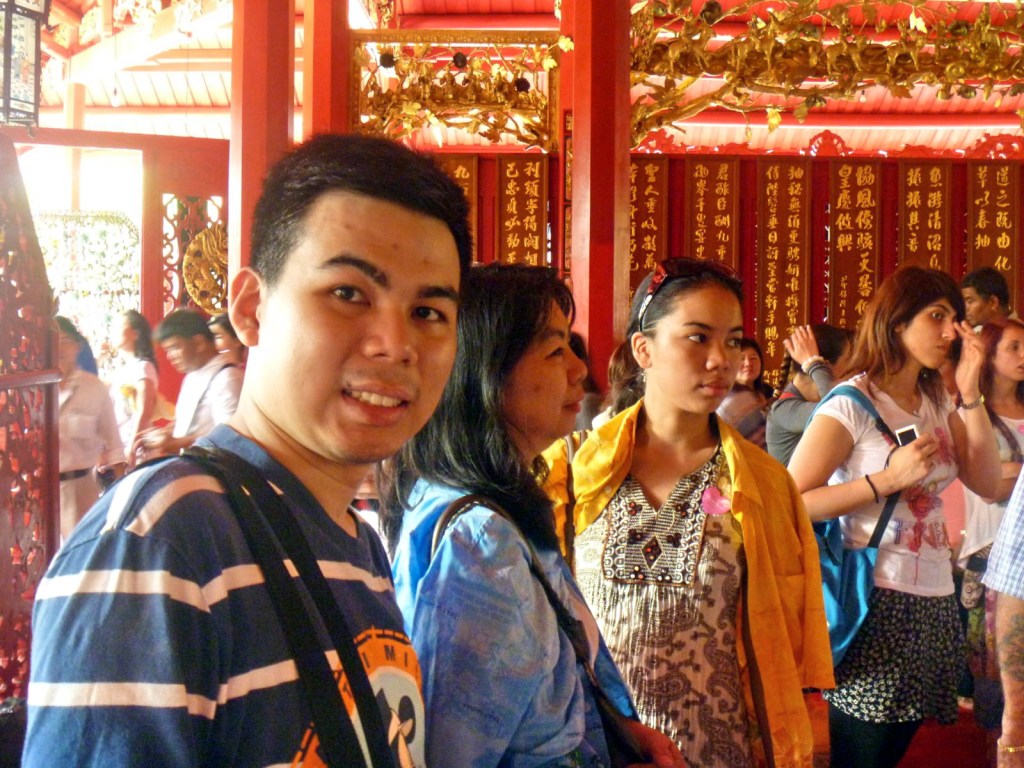On our second day in Thailand, we decide to go out of the city and visit the old Thai capital of Ayutthaya, a UNESCO World Heritage Site. We made our travel arrangements with a travel agency based near our hotel lobby at the ground floor. The 60-km. trip, via an airconditioned tourist bus, took just 1 hr. Our first stop, upon reaching Ayutthaya, was the Bang Pa-In Royal Palace, also known as the Summer Palace.
This palace complex, located along the bank of the Chao Phraya River, was originally constructed by King Prasat Thong in 1632 but, after the sack of Ayutthaya in 1767, it lay empty and overgrown throughout the late 18th century and early 19th century. King Mongkut (Rama IV) began to partially restore the site in the 1850s. Most of the present European-style buildings were constructed between 1872 and 1889 by King Chulalongkorn (Rama V).
Today, the palace remains largely open to visitors, as King Bhumibol Adulyadej and his family uses it only rarely for banquets and special occasions. However, as at all royal sites, proper dress was required and Grace and Cheska had to rent colored polo shirts to cover their shoulders. The grounds are not too large to be covered on foot. From the entrance, we walked along a formal entry promenade.
The buildings, very European in design, are laid out along a long rectangular, artificial and ornamental lake lined with formal landscaping. The lake serves to divide the “public” outer area of the palace from the inner private areas. Along the route, we passed the Ho Haem Montien Devaraj (Golden Palace of the God King) or King Pasart Thong Shrine. This Khmer-style, stone prasat (residence of a king or god with a corncob-shaped super-structure ), under a banyan tree, was built by King Rama V in 1879 to replace an old shrine built by villagers as an offering to King Prasart Thong of the Ayutthaya period.
On the left bank of the lake is the colonial-style, 1-storey, Neo-Classical style Saphakhan Ratchaprayun (Exhibition Hall). Originally built for the King’s brothers, it now houses a small museum covering the history of the palace.
The one-storey Warophat Phiman (Excellent and Shining Heavenly Abode) was King Chulalongkorn’s residence and throne hall. It is richly decorated in turn-of-the-century European aristocratic style, with quirky Thai touches here and there. Its audience chambers and anterooms are decorated with oil paintings, commissioned by King Chulalongkorn in 1888, depicting significant events in Thai history and scenes from Thai literature. The private apartments of this building are still used by the king and his family whenever they reside in the palace.
Opposite the lake, to the east, is the 2-storey, elaborately-constructed Phra Thinang Utthayan Phumisathian (Garden of the Secured Land) Residential Hall, considered the principal building in the palace complex. Completed in 1877, this building was built from wood and decorated with mahogany furniture ordered directly from Europe. However, it was destroyed by fire during the restoration in 1938. Its modern reconstruction, tinted alternately in dark and light green, has a more “Paris Metro” Art-Deco feel to it. Its balcony is similar in design to that of a Swiss chalet. The building is still occasionally used by the royal family and is not open to the public.
At the end of the promenade, the lake took on a more natural shape and, from a circular Spanish-style pavilion (Krajome Trae), we saw the “signature piece” of Bang Pa-In, the gracefully elegant Aisawan-Dhipaya-Asana Pavilion (The Divine Seat of Personal Freedom) in the middle of the lake. The only example of classical Thai architecture within the palace, it was built by King Chulalongkorn (Rama V) in 1876 and has 4 porches and a spired roof. From Krajome Trae, we fed the fishes with pieces from a previously paid for loaf of bread.
Opposite the Krajome Trae is the Devaraj-Kunlai (The God King Goes Forth) Gate, the principal entrance to the Inner Palace. It is connected to the Varobhas Bimarn Mansion (located in the Outer Palace) by a covered bridge with a louvered wall from which the court ladies could look out without being seen themselves.
The highlight of our visit was the opulent, Chinese-style Phra Thinang (Royal Residence) Wehart Chamrun (Heavenly Light), the only royal residence open to the public. Constructed in the Chinese Emperor style and made entirely of materials imported from China, it took 10 years to build and was completed in 1889.
It was a royal offering to King Chulalongkorn (Rama V) by the Chinese Chamber of Commerce represented by Chinese merchant Phraya Choduk Ratchasetthi (Fak) as a token of the long-lasting brotherly relationship between the Thai and Chinese peoples. King Chulachomklao usually made a royal visit here during the cool season.
Here, we had to remove your shoes to enter. Full of red, gold, dark woods and inlaid mother of pearl, it has a stupendous dragon sculpture inside carved from camel bone and a Chinese-style throne room at the ground floor. the upper storey houses an altar enshrining the name plates of King Mongkut and King Chulalongkorn with their respective queens.
Before returning, we climbed the 112-step spiral staircase up the 30 m. high, 3-storey and brightly painted Ho Withun Thasana (Sage’s Lookout), built in 1881, following in the footsteps of King Rama V who, when residing in Bang Pa-In Palace, used this hall as the place to get the bird’s eye view of the surrounding area. This hall was constructed in the form of a tower between Utthayan Phumisathian and Wehat Chamrun. Only the first two floors are open to the public.
Back at the entrance, we returned the shirts and bought some soft drinks and snacks (10-20 baht) before boarding our bus.
Bang Pa-In Palace: Bang Pa-In District, Ayutthaya, Thailand. Open daily, 8 AM-4 PM.


